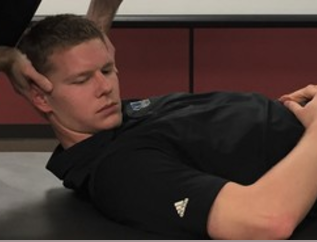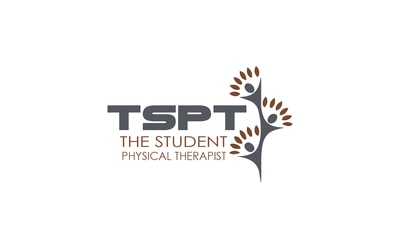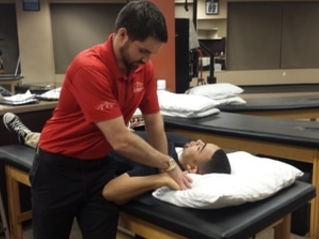- Home
- About Us
- TSPT Academy
- Online Courses
-
Resources
- Newsletter
- Business Minded Sports Physio Podcast
- Day in the Life of a Sports PT
- Residency Corner
-
Special Tests
>
-
Cervical Spine
>
- Alar Ligament Test
- Bakody's Sign
- Cervical Distraction Test
- Cervical Rotation Lateral Flexion Test
- Craniocervical Flexion Test (CCFT)
- Deep Neck Flexor Endurance Test
- Posterior-Anterior Segmental Mobility
- Segmental Mobility
- Sharp-Purser Test
- Spurling's Maneuver
- Transverse Ligament Test
- ULNT - Median
- ULNT - Radial
- ULNT - Ulnar
- Vertebral Artery Test
- Thoracic Spine >
-
Lumbar Spine/Sacroiliac Joint
>
- Active Sit-Up Test
- Alternate Gillet Test
- Crossed Straight Leg Raise Test
- Extensor Endurance Test
- FABER Test
- Fortin's Sign
- Gaenslen Test
- Gillet Test
- Gower's Sign
- Lumbar Quadrant Test
- POSH Test
- Posteroanterior Mobility
- Prone Knee Bend Test
- Prone Instability Test
- Resisted Abduction Test
- Sacral Clearing Test
- Seated Forward Flexion Test
- SIJ Compression/Distraction Test
- Slump Test
- Sphinx Test
- Spine Rotators & Multifidus Test
- Squish Test
- Standing Forward Flexion Test
- Straight Leg Raise Test
- Supine to Long Sit Test
-
Shoulder
>
- Active Compression Test
- Anterior Apprehension
- Biceps Load Test II
- Drop Arm Sign
- External Rotation Lag Sign
- Hawkins-Kennedy Impingement Sign
- Horizontal Adduction Test
- Internal Rotation Lag Sign
- Jobe Test
- Ludington's Test
- Neer Test
- Painful Arc Sign
- Pronated Load Test
- Resisted Supination External Rotation Test
- Speed's Test
- Posterior Apprehension
- Sulcus Sign
- Thoracic Outlet Tests >
- Yergason's Test
- Elbow >
- Wrist/Hand >
- Hip >
- Knee >
- Foot/Ankle >
-
Cervical Spine
>
- I want Financial Freedom
- I want Professional Growth
- I want Clinical Mastery
Cervical Distraction Test
Purpose: To assess the contribution of cervical radiculopathy to the patients symptoms.
Test Position: Supine, hooklying.
Performing the Test: Either place each hand around the patient’s mastoid processes, while standing at their head, or place one hand on their forehead and the other on the occiput. Slightly flex the patient’s neck and pull the head towards your torso, applying a distraction force. A positive test is when the patient’s symptoms are reduced with the traction.
Diagnostic Accuracy: Specificity: .90; Sensitivity: .44; -LR: .62; +LR: 4.4 (“Reliability and diagnostic accuracy of the clinical examination and patient self-report measures for cervical radiculopathy”).
Importance of the Test: As disc height decreases and bone spurs accumulate, the space for nerves to enter and exit the vertebral canal gets smaller. The decreased space can result in greater pressure on the nerve roots or other innervated structures, causing pain and weakness. With distraction, the joint space is increased to relieve the pressure on the nerve roots, thus decreasing the symptoms. This test has better diagnostic criteria when clustered with other exam measures (check out the cervical home page!).
Note: tests should only be performed by a properly trained health care practitioner.
Test Position: Supine, hooklying.
Performing the Test: Either place each hand around the patient’s mastoid processes, while standing at their head, or place one hand on their forehead and the other on the occiput. Slightly flex the patient’s neck and pull the head towards your torso, applying a distraction force. A positive test is when the patient’s symptoms are reduced with the traction.
Diagnostic Accuracy: Specificity: .90; Sensitivity: .44; -LR: .62; +LR: 4.4 (“Reliability and diagnostic accuracy of the clinical examination and patient self-report measures for cervical radiculopathy”).
Importance of the Test: As disc height decreases and bone spurs accumulate, the space for nerves to enter and exit the vertebral canal gets smaller. The decreased space can result in greater pressure on the nerve roots or other innervated structures, causing pain and weakness. With distraction, the joint space is increased to relieve the pressure on the nerve roots, thus decreasing the symptoms. This test has better diagnostic criteria when clustered with other exam measures (check out the cervical home page!).
Note: tests should only be performed by a properly trained health care practitioner.
References:
Wainner RS, Fritz JM, Irrgang JJ, Boninger ML, Delitto A, Allison S. "Reliability and diagnostic accuracy of the clinical examination and patient self-report measures for cervical radiculopathy." Spine (Phila Pa 1976) 2003 Jan 1. Web. 08/18/2012.
Wainner RS, Fritz JM, Irrgang JJ, Boninger ML, Delitto A, Allison S. "Reliability and diagnostic accuracy of the clinical examination and patient self-report measures for cervical radiculopathy." Spine (Phila Pa 1976) 2003 Jan 1. Web. 08/18/2012.
Copyright © The Student Physical Therapist LLC 2023




